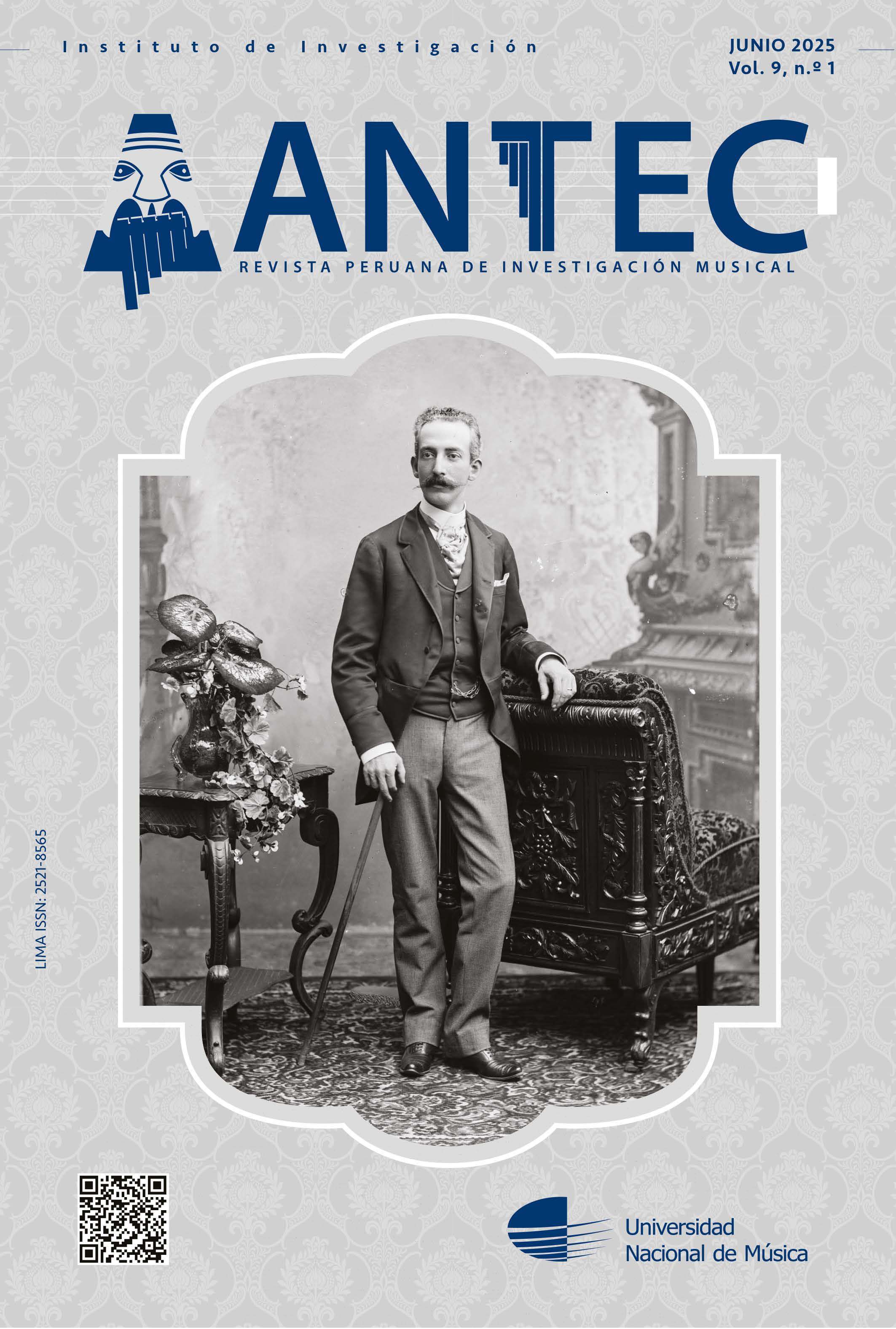Musical preferences and emotional intelligence in Peruvian high school students
DOI:
https://doi.org/10.62230/antec.v9i1.255Keywords:
Musical preferences, Emotional intelligence, Peruvian adolescents, EducationAbstract
Teenagers go through major changes in their bodies, minds and friendships, trying to adapt to what their friends and society expect of them and dealing with many problems. Harmony, in this situation, influences the culture, connections, and family of adolescents, whose musical choices are shaped by social factors and their emotional insight. This research seeks to examine the connection between melodic preferences and emotional astuteness in adolescents in East Lima. The research employs a numerical methodology, associative breadth and uncontrolled configuration, using Spearman's rank correlation metric for examination. Ordonez's (2018) “Survey of Musical Tastes” was administered to a cohort of 400 adolescents, aged 12–17 years. The findings indicate that people do not feel emotionally sharp, but liking rock music seems to help them fit in, and listening to Christian tunes helps manage stress. This reflects how auditory predilections influence affective reactions and coping in young people.
Downloads
References
Aysanoa, A. y Gallardo, . (2022). Preferencias musicales y conducta escolar en los estudiantes delnivel secundaria de la I.E. Leoncio Prado del distrito de Paúcar, provincia de Daniel AlcidesCarrión – Cerro de Pasco - 2020 [Tesis de licenciatura, Instituto superior de Música PúblicoDaniel Alomía Robles]. Repositorio Institucional de la UNDAR. http://hdl.handle.net/20.500.14556/43
Bar–on, R. (1997). BarOn Emotional Quotient Inventory Resource Report
Benhamu, T. (2017). Factores influyentes en las preferencias musicales de los alumnos de educaciónprimaria [Trabajo de Fin de Grado, Universidad de Sevilla]. IDUS. http://hdl.handle.net/11441/62890
Bradshaw, M., Ellison, C. G., Fang, Q., & Mueller, C. (2015). Listening to religious music and mentalhealth in later life. Gerontologist, 55(6), 961–971. https://doi.org/10.1093/geront/gnu020
Bernal, A., & Gil, J. A. (2019, 15-29 de marzo). La inteligencia emocional a través de la música[ponencia]. En J. C. Martínez (Coord.). IV Congreso internacional virtual sobre LaEducación en el Siglo XXI. Málaga, España. https://www.eumed.net/actas/19/educacion/16-la-inteligencia-emocional-a-traves-de-la-musica.pdf
Broc, M. A. (2019). Inteligencia emocional y rendimiento académico en alumnos de educaciónsecundaria obligatoria. Revista de Educación y Desarrollo, 30(50009), 17. https://doi.org/10.5944/reop.vol.30.num.1.2019.25195
Chamorro–Premuzic, T., & Furnham, A. (2007). Personality and music: Can traits explain howpeople use music in everyday life? British Journal of Psychology, 98(2), 175–185. https://doi.org/10.1348/000712606X111177
Citro, S. (2008). El Rock como un ritual adolescente. Trasgresión y realismo grotesco en losrecitales de Bersuit. TRANS. Revista Transcultural de Música, 12. http://www.sibetrans.com/trans/trans12/art03.htm
Cook, T., Roy, A. R. K., & Welker, K. M. (2019). Music as an emotion regulation strategy: Anexamination of genres of music and their roles in emotion regulation. Psychology of Music,47(1), 144–154. https://doi.org/10.1177/0305735617734627
Espinoza, B., Katherine, L., Calle, L., Agusta, M., Pañora, R., Elizabeth, P., Faicán, E., Gabriela,R., & Huayta, Y. J. (2022). Desarrollo psicológico del adolescente: Una revisión sistemática.EDUCARE ET COMUNICARE: Revista de Investigación de La Facultad de Humanidades, 6, 389–398. https://doi.org/10.29018/issn.2588–1000vol6iss42.2022pp389–398
Garay, A. (1996). El rock como conformador de identidades juveniles. Ansiedad y Estrés, 26(1) https://www.redalyc.org/articulo.oa?id=105118896002
Gonzáles, F., Estaún, S., & Cladellas, R. (2020). Música como reductor de ansiedad: Un estudiopiloto. Ansiedad y Estrés, 26(1) 46–51. https://doi.org/10.1016/j.anyes.2020.02.001
Gutiérrez, J. R., Flores, R. A., Flores, R., & Huayta, Y. J. (2021). Inteligencia emocional adolescente:una revisión sistemática. EDUCARE ET COMUNICARE: Revista de Investigación de LaFacultad de Humanidades, 9(1), 59–66. https://doi.org/10.35383/educare.v9i1.576
Jakubowski, K., & Ghosh, A. (2021). Music–evoked autobiographical memories in everyday life.Consciousness and Cognition, 94, 103160. https://doi.org/10.1016/j.concog.2021.103160
Koelsch, S. (2010). Towards a neural basis of music–evoked emotions. Trends in Cognitive Sciences,14(3), 131–137. https://doi.org/10.1016/j.tics.2010.01.002
Marín, J. S. (2023). Influencia de la música en el comportamiento de los adolescentes. Ciencia yAcademia, (4), 201-211. https://doi.org/10.21501/2744838X.4652
Mayer, J. D., Salovey, P., & Caruso, D. R. (2004). Emotional intelligence: Theory, findings, andimplications. Psychological Inquiry, 15(3), 197–215. https://doi.org/10.1207/s15327965pli1503_02
Ministerio de Salud. (2021). Minsa: El 29.6% de adolescentes entre los 12 y 17 años presenta riesgo de padeceralgún problema de salud mental o emocional. https://www.gob.pe/institucion/minsa/noticias/536664–minsa–el–29–6–de–adolescentes–entre–los–12–y–17–anos–presenta–riesgo–de–padecer–algun–problema–de–salud–mental–o–emocional
Organización Mundial de la Salud. (2021). Salud mental en adolescentes. https://www.who.int/es/news–room/fact–sheets/detail/adolescent–mental–health
Ordoñez, P. (2018). Género musical y conducta en estudiantes del 4to grado de la institución educativaMicaela Bastidas Puyucahua Huancavelica, 2018 [Tesis de licenciatura, Universidad Nacional deHuancavelica]. Repositorio Institucional – UNH. http://repositorio.unh.edu.pe/handle/UNH/2162
Ordoñez, V., Rubio, L., & Rendón, L. (2022). La influencia de la música en las emociones ycomportamiento de las personas. [Tesis de licenciatura, Corporación Universitaria Minuto deDios]. Uniminuto. https://repository.uniminuto.edu/bitstream/10656/17470/1/16
Papinczak, Z., Dingle, G. A., Stoyanov, S. R., Hides, L., & Zelenko, O. (2015). Young people's usesof music for well–being. Journal of Youth Studies, 18(9), 1119–1134. https://doi.org/10.1080/13676261.2015.1020935
Saarikallio, S. (2011). Music as emotional self–regulation throughout adulthood. Psychology of Music,39(3), 307–327. https://doi.org/10.1177/0305735610374894
Saarikallio, S., & McFerran, K. S. (2022). Musical care in adolescence: Supporting healthy musicalidentities and uses of music. En R. MacDonald (Ed.), Collaborative insights: Interdisciplinaryperspectives on musical care throughout the life course (pp. 70–85). Oxford University Press. https://academic.oup.com/book/43154/chapter/362182392
Ugarriza Chávez, N., & Pajares Del Águila, L. (2006). La evaluación de la inteligencia emocional através del inventario de BarOn ICE: NA, en una muestra de niños y adolescentes. Persona,8, 11–58. https://www.redalyc.org/pdf/1471/147112816001.pdf
Vales, L. (2021). Música, emociones y Neurociencias: influencia de la música en las emociones y sus efectosterapéuticos. [Tesis de licenciatura, Universidad de la República]. Colibrí. https://www.colibri.udelar.edu.uy/jspui/handle/20.500.12008/30492
Zijtveld, C. (2021). Music and identity: The role of music preference in predicting educational identity andself–concept clarity [Tesis de maestría, Utrecht University]. Utrecht University Repository. https://studenttheses.uu.nl/handle/20.500.12932/424
Downloads
Published
Issue
Section
License
Copyright (c) 2025 Antec: Revista Peruana de Investigación Musical

This work is licensed under a Creative Commons Attribution-NonCommercial-NoDerivatives 4.0 International License.














